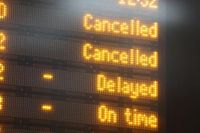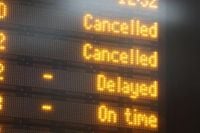It’s a familiar story for commuters across the UK: you’re waiting for your train, glancing anxiously at the departure board, only to see your service marked as cancelled. For millions, this isn’t just an occasional inconvenience—it’s become a defining feature of the rail experience. According to a recent BBC analysis of Office of Rail and Road (ORR) figures, around three million out of 89 million scheduled train stops were cancelled in the UK, painting a stark picture of the nation’s railway reliability as of September 23, 2025.
City Thameslink in London stands out for all the wrong reasons. Of almost 150,000 scheduled stops at this central station, about one in 13 were cancelled, making it the worst performer among the 100 busiest stations in the UK. This translates to a cancellation rate significantly above the national average, and it’s a figure that’s hard to ignore for the thousands who depend on those trains every day.
The BBC’s deep dive into the ORR data didn’t just single out City Thameslink. It revealed a patchwork of frustration across the country, with certain regions and stations faring much worse than others. The overall average cancellation rate in the UK was 3.3 percent, but the numbers tell a more nuanced story when broken down by region. The North East topped the charts with a 4.5 percent cancellation rate, followed by the South West at 4.2 percent, the North West at 4 percent, Wales at 3.9 percent, and the West Midlands at 3.8 percent. England’s overall rate sat at 3.5 percent, while Scotland boasted the lowest at just 2 percent—a rare bright spot in a sea of delays and disappointment.
Drilling down further, the statistics reveal just how widespread the problem is. In Wales, Newport led the pack with a 5.4 percent cancellation rate, trailed by Cardiff Queen Street at 4.3 percent and Cathays at 4.1 percent. The South West saw Cheltenham Spa hit a staggering 6.9 percent, with Bristol Temple Meads and Bristol Parkway not far behind at 4.8 and 4.6 percent, respectively. The North East’s Hartlepool clocked in at 5.9 percent, while both MetroCentre and Sunderland reached 5.8 percent.
London, the heart of the UK’s rail network, wasn’t immune either. Farringdon recorded a 4.9 percent cancellation rate, with Euston and Paddington both at 3.4 percent. Yorkshire and the Humber had their own trouble spots: Halifax topped the list at 5.5 percent, and Bradford Interchange saw 5.1 percent of its scheduled stops cancelled. In the South East, Gatwick Airport had a 5.8 percent cancellation rate, Brighton 4.2 percent, and Reading 3.8 percent. The East Midlands’ Kettering and Northampton had rates of 3.6 and 3.5 percent, respectively, while St Albans City in the East of England endured the highest rate in that region at 7.6 percent, followed by Luton Airport Parkway at 6.9 percent and Stevenage at 5.8 percent. Manchester Airport in the North West was the worst in its region with a 7.1 percent cancellation rate, ahead of Preston at 5.4 percent and Manchester Oxford Road at 5 percent.
Yet, amid these grim numbers, Scotland’s busiest stations offered a glimmer of hope. None of the top ten busiest Scottish stations exceeded the national average cancellation rate. Exhibition Centre in Glasgow had a 2.8 percent rate, and Patrick followed closely at 2.7 percent, underlining a level of reliability that many commuters elsewhere can only envy.
Zooming in on Yorkshire, the figures are particularly eye-opening. In the year leading up to August 2025, nearly 7,000 train services to Sheffield were cancelled—more than 4 percent of all scheduled services to the city. According to the BBC, Sheffield had the highest cancellation rate among Yorkshire’s busiest stations within the UK’s top 100. Leeds and York, the other major stations in the region, experienced nearly 15,000 cancellations out of 500,000 scheduled stops combined. Leeds, ranked as the 16th busiest station in the country, had a 3 percent cancellation rate, while York’s rate was 2.7 percent.
Smaller stations didn’t escape unscathed. Bradford Interchange, Halifax, Rotherham Central, and New Pudsey each saw at least 5 percent of services cancelled. For passengers, the impact is personal and immediate. Marie Boreham, a regular at Sheffield Station, voiced the frustration felt by many: “You’re wasting time, it affects all of your day. It should definitely be more reliable, you’ve come out for that train especially – it’s wrong.”
Others, like Nathaniel Chadwick, described the ripple effects of delays and cancellations on daily life. “It’s not ideal when they’re cancelled, because she’s only four and she goes to sleep early,” he said of his journeys from Bradford Interchange to Manchester to see his daughter. “They need to sort it out - either get a bigger station or get better services, because people do commute from Bradford to Manchester. You could be looking at the sack or a warning because you’re late.”
Jabbar Ali, another Bradford passenger, summed up the coping strategies many have adopted: “I have to set off a bit early and get an earlier train in case the next one’s late or cancelled.” It’s a workaround, but hardly a solution for a system meant to run on timetables and predictability.
Rail operators and government officials are keenly aware of the dissatisfaction. Matt Rice, Northern’s chief operating officer, acknowledged the challenges: “We have been working hard to stabilise performance and cut cancellations in recent months. There are green shoots of progress, but we know more work needs to be done before we can deliver lasting improvements for our customers.”
The Department for Transport echoed this sentiment, stating, “We are determined to drive up standards across the railways, as we deliver the biggest overhaul of the railways in a generation.”
There are signs of improvement. Rail punctuality in Yorkshire, for example, has inched upwards in recent years. Between April and June 2025, Northern and LNER reported cancellation rates of 3.3 percent and 2.1 percent, respectively, according to the ORR. TransPennine Express (TPE), once plagued by a 40 percent cancellation rate in early 2023 due to a shortage of drivers, has seen significant gains since being brought under public control in May 2023 and launching an intensive training program. Now, LNER, Northern, and TPE are all run directly by the Department for Transport, with CrossCountry and East Midlands Railway set to follow suit.
Investment is also on the table. In late 2023, the government earmarked £2 billion for a new station in Bradford, though as of September 2025, a business case for the scheme had yet to be published. Whether this investment will translate into tangible improvements for passengers remains to be seen.
As the UK’s railways grapple with persistent cancellations and the public’s growing impatience, the data paints a picture of a system in flux—one where reliability varies widely by region and station, and where the promise of improvement is met with a healthy dose of skepticism from those who rely on the trains most. For now, passengers wait, hope, and—more often than they’d like—rearrange their days around the next cancelled service.


